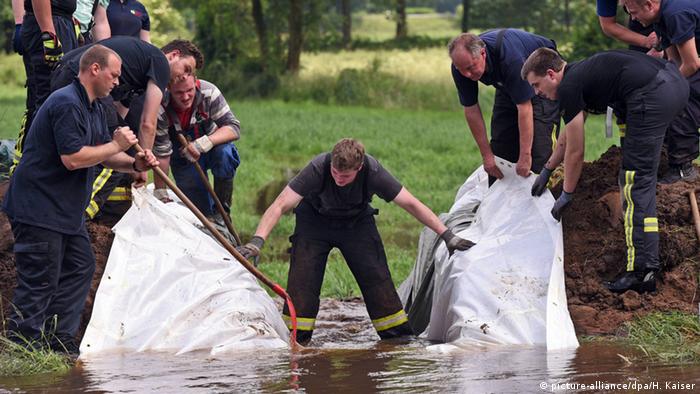Europe’s downpours persist, causing deaths in France, Belgium, Germany and Romania
Days of cloudbursts across western Europe have caused ten deaths in Germany, two in France and Romania and one in Belgium. The River Seine in Paris is six meters higher than normal.
Germany’s DWD meteorological service warned Friday of more localized but dramatic downpours extending into Belgium and France as a moist weather low hovered over much of western Europe.
In Paris, staff at the Louvre museum removed artworks from the lower floors as the river Seine neared six meters above its normal level – the highest in more than three decades.
A beekeeper, swept downstream while trying to rescue his hives at Harsin in southern Belgium, was found dead on Friday.
Authorities in eastern Romania said two men had lost their lives in flood waters.
Sixth victim in Bavaria
Residents of Germany’s flooded southern Inn valley in Bavaria on the border with Austria mourned their sixth flooding victim on Friday. The 65-year-old man’s body was found overnight in the town of Simbach am Inn, which was inundated on Wednesday. An elderly couple are still missing.
Localized flooding that began last Sunday had already claimed four lives in Baden-Württemberg in Germany’s southwest.
Emergency workers who had placed sand sacks to safeguard dykes in two towns in North Rhine Westphalia (NRW) state – Isselburg and Hamminkeln, near the lower reaches of the Rhine – said water levels were falling early Friday.
Two people struck by lightning
Lightning strikes near NRW’s city of Krefeld left two men severely injured according to the local fire service.
As in Bavaria, emergency workers across NRW were busy pumping out flooded cellars, removing downed trees and securing construction sites.
In the hilly Eiffel region of Rhineland-Palatinate, a Rhine tributary, the Ahr river was in full flood and school pupils were told to stay at home.
Festival-goers converging on Mendig in the southern Eiffel for the annual “Rock am Ring” extravaganza were anticipating muddy campsites. Organizers stopped private vehicle access and instead recommended arrivals via bus and train.
Forecasters cautious
The German DWD weather service pleaded for caution despite tentative forecasts into early next week for drier weather, extending up to 27 degrees Centigrade (81 degrees Fahrenheit).
“New falls of precipitation will reach Germany that will have potential to cause severe storms,” said the service.
DWD expert Andreas Becker said the exact locations of so-called “storm cells” were only predictable one to one-and-half hours in advance.
Downpours of between 25 liters per square meter and in extreme localized cases up to 60 liters per square meter, with hail, could not be ruled out, the DWD warned.
Precautionary evacuation in Paris
In Paris, deputy mayor Bruno Julliard said that although museum storerooms were not yet flooded the relocation of artworks at the Louvre was a precautionary move.
Flooding snarled traffic in Paris and forced the shutdown of several railway stations.
Elsewhere, similar flood-related closures applied at Paris’ Orsay and the castles of Cambord and Azay-led Rideau.
The interior ministry said a horse-rider who fell into a river in the Seine-Marne region east of Paris had become France’s second flood victim.
Some 20,000 people had been evacuated from their homes across France, the ministry said.
South of Paris, dozens of schools were closed. Soldiers were called in to rescue stranded highway motorists.
Climate change to blame?
Germany’s Potsdam institute for climate research said the persistent moist low pressure weather system over Europe could be attributed to climate change, although more data was needed for statistical certainty.
Institute spokesman Peter Hoffman said a possible cause for the sodden weather was that the Arctic this season had warmed faster that southern regions resulting in only a slow eastward drift of weather systems from the Atlantic across continental Europe.
Simultaneously, moist warm air masses were reaching Europe from southern regions such as northern Africa and the equatorial Atlantic.
Slow eastward drift
The interaction between the cool air masses from the north and moisture-laden warm air masses from the south was resulting in heavy rains and thunderstorms, he said.
“A warm atmosphere can absorb more moisture; then more water falls when it rains,” Hoffmann explained.
DWD’s Becker said the prevailing low pressure system could still drift toward the Bohemia region of the Czech Republic, creating a scenario similar to Europe’s dramatic flooding in 2013.
ipj/jm (dpa, AP, Reuters, AFP)
